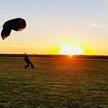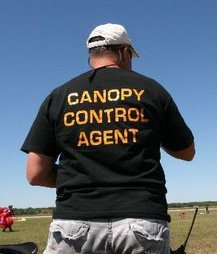Recommended Posts
Skydog73 0
QuoteQuoteOn the other hand, if you have a low-time student in the air and the coach or another jumper point down (to indicate a bad spot) or points at their altimeter (I know this isn't a valid hand signal, but I've seen it done many times) you don't necessarily want the student to immediately pull.
You don't need to point at your alti. Tap it with all four fingers or the palm of your hand. I also like putting my alti in my face until the student gets the hint. Both work.
You don't need to point down with one finger to indicate a bad spot. You can put two fingers to your eyeballs then wave both of those fingers to the place you want them to look. They understand, "look over there".
Both of these sign language clues seem to work with many students with zero training because they just make sense.
If you want someone to track or go some direction, point with all four fingers stuck out and thumb at the palm of your hand. Wave in the direction you want them to go starting with elbow bent, fingers to the sky eventually arm extended the direction you want them to go. This one makes so much sense most dogs understand it when you want to play fetch, so humans should too.
Don Yarling taught me this when I was getting my coach rating. We were in the middle of an eval, and he said something. I gestured "good point", on the ground, and my hand resembled a "pull" signal. He yelled, "arch, reach, throw!" loud enough everyone within a mile could hear. Then said to me, "why would you tell me to pull on the ground?" It was his dramatic show that taught me a lesson such that I remember this to this day.
Our coach/AFF E does the same drill, anytime anyone points he makes us all yell the same thing.
And during an AFF rating jump a friend was on, he tapped his finger on the AFF E's alti, on the ground the examiner said "hey why did you give me the pull sign at 9000', he said next time tap all 4 fingers on the alti, if your going to pratice a sign, pratice it correctly was his point.
Seems most of us agree on this topic, and I thank you for your input.
QuoteI gestured "good point", on the ground, and my hand resembled a "pull" signal. He yelled, "arch, reach, throw!" loud enough everyone within a mile could hear. .
I sometimes tell student that if they want t o mess with their instructors, watch to see how they point out ground references on the plane. If they use their index finger to point, yell out real, real loud, "WHY DID YOU TELL ME TO PULL"?
I think we're all Bozos on this bus.
Falcon5232, SCS8170, SCSA353, POPS9398, DS239
ufk22 32
As I said, the most important thing is that everyone at the DZ be on the same page.
tdog 0
Quote
As I said, the most important thing is that everyone at the DZ be on the same page.
That I agree with...
Thus, at at least the DZ I frequent, your statement is wrong:
QuoteJust like the proper signal for altitude check is "circle of awareness", not tapping on their altimeter or yours
Every DZ has slight variations and that is ok... At least for people I teach, the circle of awareness hand signal means do a full circle of awareness with 4 steps (horizon, alti, instructor, instructor). Tapping an altimeter (or even the opposite wrist) means look at your alti. The students are trained this in a video, in the FJC, and by the instructors.
The full circle of awareness is phased out in the first few jumps with a student, and by the time they are on a coach jump, "horizon, alti, instructor, instructor" is not a useful thing for most diveflows.
Further, we tell students "do only two circles of awareness on a level 1, after that just keep checking your alti and the horizon/heading in short circles every few seconds." And we tell them, "we will only give you hand signals for practice touches or COA if you forget to do them on your own."
After a student does two great COAs, to conflict with what we trained them and to ask them to do a whole new 3rd COA just because we feel it has been a tad long since they checked their alti, does not make sense to me. The student might think, "I just did a full COA, why again?"
I get postive feedback from the students in the debrief understanding the COA vs tap on wrist, "you tapped my wrist, I checked my alti, and I realized I was slacking. I saw it was close to pull time so I checked it again and pulled."
Everyone has their own technique. And that is alright. So the moral to the story is - if you are a coach, instructor, etc - ask your student what signals they know before the jump and use those, or train new ones. Hopefully matching ones others at the DZ use. It is like my friends dog who knew to pee every time his owner said "john lennon", it does not matter as long as both creatures are on the same page. That being said, the pull signal (both pointing one finger, and waving and pulling) is the pull signal and that is pretty darn universal and should be given a lot of respect.
rehmwa 2
QuoteAs I said, the most important thing is that everyone at the DZ be on the same page.
I like that. But the most important thing for me is that the student and I are on the same page on whatever jump we're on - it certainly does help to have a default set of expectations at the DZ or in general - but we still talk about hand signals in the prebrief/training just to be clear for any coaching or AFF jump (you never know what the last guy taught him unless you review)
it doesn't take long - "you remember your hand signals?.....ok, what does this mean, and this, and this....great, here's a couple new ones for this jump" etc etc
...
Driving is a one dimensional activity - a monkey can do it - being proud of your driving abilities is like being proud of being able to put on pants
ufk22 32
QuoteQuoteAs I said, the most important thing is that everyone at the DZ be on the same page.
I like that. But the most important thing for me is that the student and I are on the same page on whatever jump we're on - it certainly does help to have a default set of expectations at the DZ or in general - but we still talk about hand signals in the prebrief/training just to be clear for any coaching or AFF jump (you never know what the last guy taught him unless you review)
it doesn't take long - "you remember your hand signals?.....ok, what does this mean, and this, and this....great, here's a couple new ones for this jump" etc etc
Without a doubt.
My only point is that it's a lot less confusing for the student, and lowers the chance of brainlock, if eveyone at the DZ is teaching the same thing rather than the student to have to learn different signals every jump.
tdog 0
Quoteit doesn't take long - "you remember your hand signals?.....ok, what does this mean, and this, and this....great, here's a couple new ones for this jump" etc etc
As another side tidbit -
I found that "practice touches" was often misunderstood/forgotten. So now I have the student teach me the signals in all review sessions. I find retention has gone up a great deal when they form the signals with their hands during review... You see their brain churn as they try to remember then it clicks.
rehmwa 2
Quotenow I have the student teach me the signals in all review sessions. I find retention has gone up a great deal .....
EXCELLENT idea - I'll start incorporating that immediately
thanks
...
Driving is a one dimensional activity - a monkey can do it - being proud of your driving abilities is like being proud of being able to put on pants
QuoteQuoteit doesn't take long - "you remember your hand signals?.....ok, what does this mean, and this, and this....great, here's a couple new ones for this jump" etc etc
As another side tidbit -
I found that "practice touches" was often misunderstood/forgotten. So now I have the student teach me the signals in all review sessions. I find retention has gone up a great deal when they form the signals with their hands during review... You see their brain churn as they try to remember then it clicks.
Great Idea!
Matt
So, start being safe, first!!!
Skydog73 0
I flat out tell students at this stage I should not be telling you to pull, i review the signals, and then add in that if I roll my arm extended in a direction that means turn and track and deploy, and if you ever see me pull, you should be pulling as well.
Like I said I will abide by the rules either way, just want everyone doing the same thing here on a day to day basis and not causing confusion, what we do in freak situations is a judgement call usually anyway, but this has given me a few new scenarios to think about, so either way it has been helpful!!!!
JohnMitchell 14
Damn, I love it when I pick up a new teaching tool. Thanks, Tdog.QuoteSo now I have the student teach me the signals in all review sessions. I find retention has gone up a great deal when they form the signals with their hands during review...




You don't need to point at your alti. Tap it with all four fingers or the palm of your hand. I also like putting my alti in my face until the student gets the hint. Both work.
You don't need to point down with one finger to indicate a bad spot. You can put two fingers to your eyeballs then wave both of those fingers to the place you want them to look. They understand, "look over there".
Both of these sign language clues seem to work with many students with zero training because they just make sense.
If you want someone to track or go some direction, point with all four fingers stuck out and thumb at the palm of your hand. Wave in the direction you want them to go starting with elbow bent, fingers to the sky eventually arm extended the direction you want them to go. This one makes so much sense most dogs understand it when you want to play fetch, so humans should too.
Don Yarling taught me this when I was getting my coach rating. We were in the middle of an eval, and he said something. I gestured "good point", on the ground, and my hand resembled a "pull" signal. He yelled, "arch, reach, throw!" loud enough everyone within a mile could hear. Then said to me, "why would you tell me to pull on the ground?" It was his dramatic show that taught me a lesson such that I remember this to this day.
Share this post
Link to post
Share on other sites